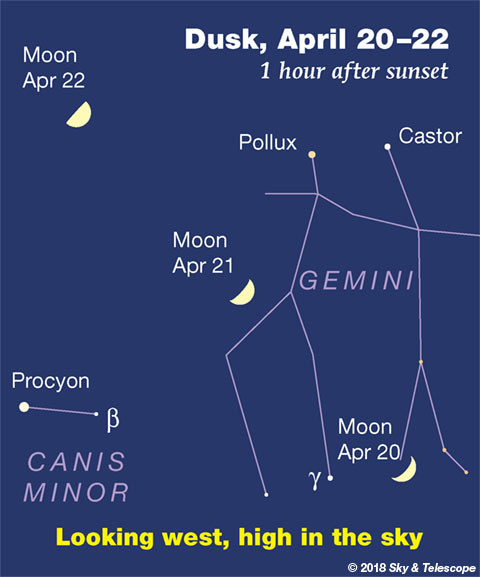
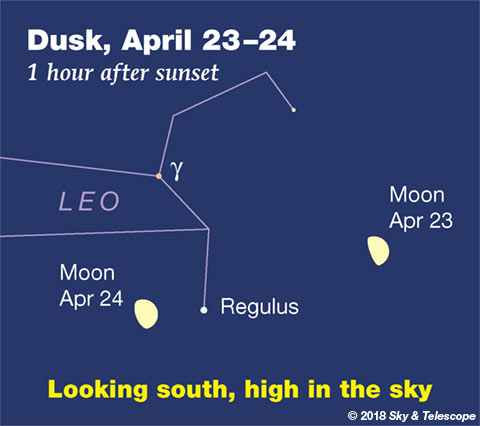
Friday, April 20
• This evening the dark limb of the crescent Moon will occult 4th-magnitude multiple star Nu Geminorum, in the feet of Gemini, for parts of the southern U.S. and points south. For rough time estimates at your location, interpolate between the time predictions in the April Sky & Telescope, page 48.
Saturday, April 21
• It's Spring Astronomy Day! Check for local public events near you.
• The Moon, almost first quarter, shines to the lower left of Pollux and Castor after dark, awaiting public viewing with telescopes at Astronomy Day events.
And Castor is a fine telescopic double star — a triple including its distant red-dwarf companion Castor C (YY Geminorum), not too faint at magnitude 9.8. Find it 71 arcseconds to the bright pair's south-southeast. Its color is visible in my 6-inch scope. Castor A and B are currently 5.2 arcseconds apart.
• The Lyrid meteor shower should be weakly active from about midnight tonight until the first light of dawn Sunday morning. The Moon, nearly first quarter, sets around 2 a.m. local daylight-saving time. The shower may produce about a dozen meteors visible per hour for a watcher under an excellent dark sky; fewer under more ordinary conditions.
Sunday, April 22
• First-quarter Moon (exact at 5:46 p.m. EDT). The Moon now shines to the left of Castor and Pollux and above Procyon. Far below Procyon at nightfall, look for brighter Sirius.
After dark, use binoculars to pick out members of the Beehive Star Cluster just a few degrees above the Moon, in the same field of view (for North America). They're almost lost in the moonlight.
Monday, April 23
• As night descends, Pollux and Castor are high in the west lined up almost horizontally (depending on your latitude). The heads of the Gemini twins, they form the top of the enormous Arch of Spring. To their lower left is Procyon, the left end of the Arch. Farther to their lower right is the right end, formed by Menkalinan (Beta Aurigae) and then brilliant Capella. The whole thing sinks in the west through the evening.
Modern skywatchers are not alone in seeing the Arch of Spring as one big asterism. Extend it down past Procyon to add Sirius, and you've got the Hawaiian Canoe-Bailer of Makali‘i.
Tuesday, April 24
• The waxing gibbous Moon shines near Regulus this evening.
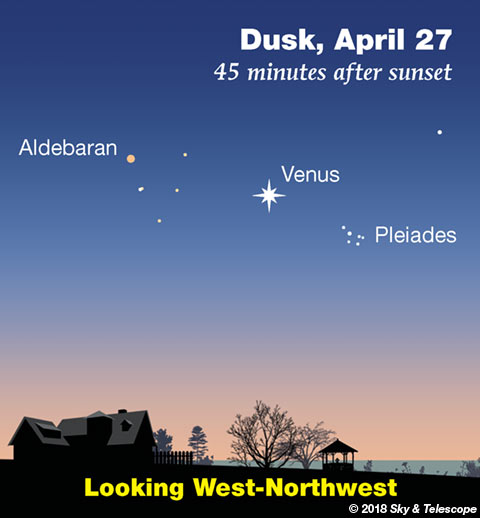
Wednesday, April 25
• Arcturus is the brightest star in the east these evenings. Spica shines about three fists at arm's length to its lower right. To the right of Spica by half that distance is the distinctive four-star constellation of Corvus, the Crow of Spring.
Thursday, April 26
• Face north just after nightfall, look very high, and now you'll find the Pointers, the end stars of the Big Dipper's bowl, on the meridian pointing toward Polaris straight down below. From the Pointers to Polaris is about three fists at arm's length.
Friday, April 27
• Look below the bright Moon this evening for Spica. Jupiter rises far to their lower left around the end of twilight.
Saturday, April 28
• Now Spica shines to the right of the Moon (which is nearly full) during evening. Jupiter rises to the Moon's lower left.
________________________
Want to become a better astronomer? Learn your way around the constellations! They're the key to locating everything fainter and deeper to hunt with binoculars or a telescope.
This is an outdoor nature hobby. For an easy-to-use constellation guide covering the whole evening sky, use the big monthly map in the center of each issue of Sky & Telescope, the essential guide to astronomy.

Once you get a telescope, to put it to good use you'll need a detailed, large-scale sky atlas (set of charts). The basic standard is the Pocket Sky Atlas (in either the original or Jumbo Edition), which shows stars to magnitude 7.6.
Next up is the larger and deeper Sky Atlas 2000.0, plotting stars to magnitude 8.5; nearly three times as many. The next up, once you know your way around, is the even larger Uranometria 2000.0 (stars to magnitude 9.75). And read how to use sky charts with a telescope.
You'll also want a good deep-sky guidebook, such as Sue French's Deep-Sky Wonders collection (which includes its own charts), Sky Atlas 2000.0 Companion by Strong and Sinnott, or the bigger Night Sky Observer's Guide by Kepple and Sanner.
Can a computerized telescope replace charts? Not for beginners, I don't think, and not on mounts and tripods that are less than top-quality mechanically (meaning heavy and expensive). And as Terence Dickinson and Alan Dyer say in their Backyard Astronomer's Guide, "A full appreciation of the universe cannot come without developing the skills to find things in the sky and understanding how the sky works. This knowledge comes only by spending time under the stars with star maps in hand."
This Week's Planet Roundup
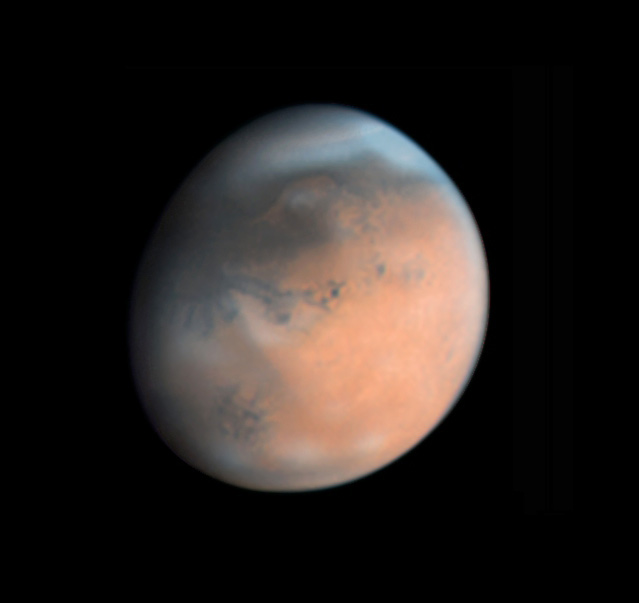
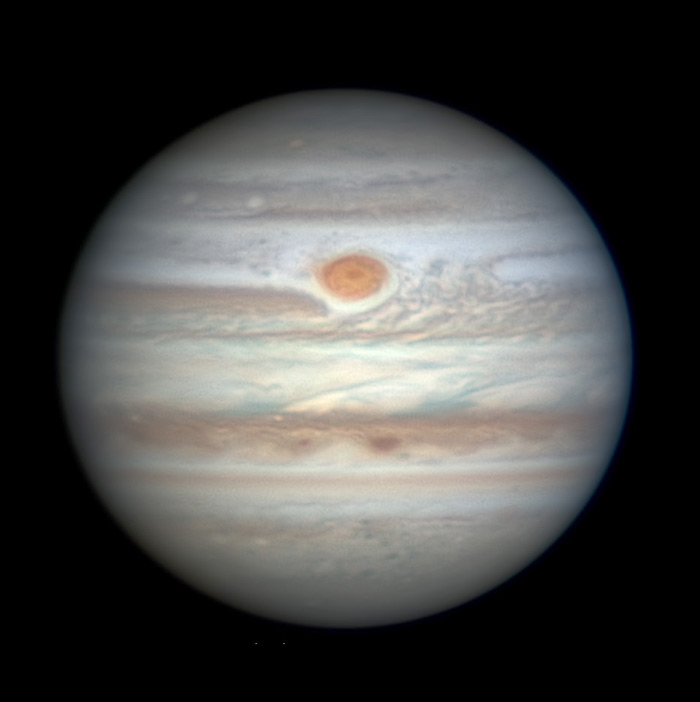
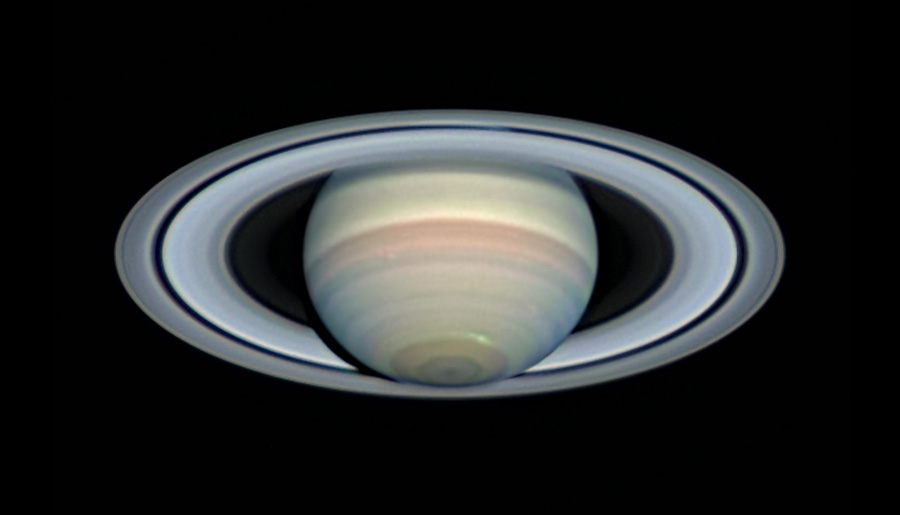
Mercury is having a very low, poor apparition deep in the glow of sunrise.
Venus (magnitude –3.9) shines brightly in the west in twilight. It doesn't set now until about a half hour after night becomes complete (if you have a perfectly flat west-northwest horizon). This week Venus passes the Pleiades; it moves from below the Pleiades on April 20th to upper left of the cluster by the 27th. On the 26th and 27th, Venus is in line between the Pleiades and Aldebaran, as shown above.
In a telescope (look early!) Venus is a tiny disk 11 arcseconds wide and slightly gibbous: 90% sunlit.
Mars and Saturn have both risen by about 2 a.m. daylight-saving time. They're in Sagittarius, shining at magnitudes –0.2 and +0.4, respectively, with Mars on the lower left. By early dawn they're higher in the south. Their separation widens slightly from 10° on the morning of April 21st to 13° on the 28th.
Mars is brightening on its way to an unusually close opposition in late July. It's already 10 arcseconds wide.
Jupiter (magnitude –2.5, in Libra) rises around the end of twilight after dark and shines as the brightest point in the sky after Venus sets. It's two weeks from its May 8th opposition, so it appears about as bright and big (44 arcseconds wide) as it will get this year. It's highest in the south, presenting the sharpest views in a telescope, around 1 or 2 a.m. daylight-saving time. By dawn it's getting low in the southwest.
Uranus is hidden in the glare of the Sun.
Neptune is deep in the skyglow of dawn.
______________________
All descriptions that relate to your horizon — including the words up, down, right, and left — are written for the world's mid-northern latitudes. Descriptions that also depend on longitude (mainly Moon positions) are for North America.
Eastern Daylight Time (EDT) is Universal Time (also called UT, UTC, GMT, or Z time) minus 4 hours.
______________________
"Remember to look up at the stars and not down at your feet. Try to make sense of what you see and wonder about what makes the universe exist. Be curious."
— Stephen Hawking, 1942–2018
______________________
"The dangers of not thinking clearly are much greater now than ever before. It's not that there's something new in our way of thinking, it's that credulous and confused thinking can be much more lethal in ways it was never before."
— Carl Sagan, 1996
______________________
"Objective reality exists. Facts are often determinable. Vaccines save lives. Carbon dioxide warms the globe. Bacteria evolve to thwart antibiotics, because evolution. Science and reason are not a liberal conspiracy. They are how we determine facts. Civilization's survival depends on our ability, and willingness, to do so."
— Alan MacRobert, your Sky at a Glance editor
______________________
"Facts are stubborn things."
— John Adams, 1770
 0
0








Comments
You must be logged in to post a comment.